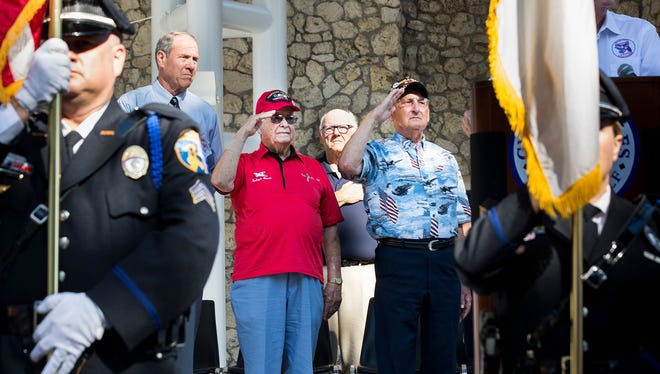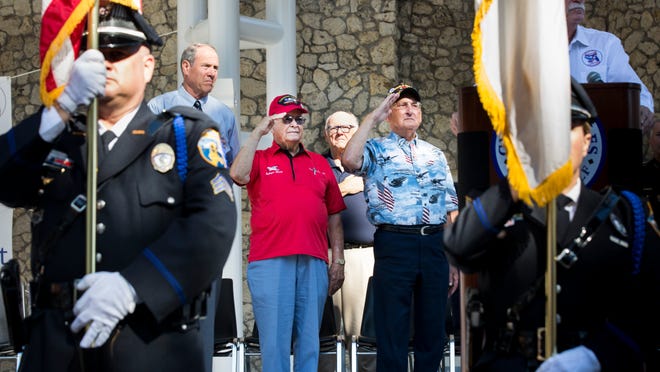WWII airmen, segregated by race, finally meet decades later


NAPLES, Fla. — For two retired lieutenant colonels from World War II, their reunion was decades in the making.
Vernon "Bo" Sigo and George Hardy both flew countless missions over war-torn Europe, dodging flak and enemy planes. They both were stationed at military bases in Italy, about 25 miles from each other. There's a good chance they flew side by side at one point during the conflict.
And yet, they were worlds apart.
Sigo, who is white, was a navigator in a heavy Boeing B-17 bomber.
Hardy, who is black, was a P-51 Mustang pilot and one of the legendary Tuskegee Airmen — the African-American pilots who often escorted and protected bombers, such as Sigo's, on their missions.
Related: British WWII veteran, 101, breaks skydiving record
But though they fought for a common goal, their country and military demanded they be separated.
"In World War II, we were completely segregated," said Hardy, 91, of Sarasota, Fla. "We rarely ever met a white pilot, because we were on separate bases. And segregation was the way it was."
When Sigo, 92, learned it was the Tuskegee Airmen who had protected him during his dozens of missions through enemy territory, he made it his goal to meet one and personally thank him.
He had to wait 72 years to do so, but earlier this month in front of a crowd of fellow veterans, schoolchildren, city officials and dignitaries at Cambier Park in Naples, Fla., Sigo finally got his wish.
Related: Oldest living World War II veteran Richard Overton turns 111
"After the war, I found out those P-51s were flown by Tuskegee Airmen. It's been my hope that one day I could thank a Tuskegee Airman personally for their service. Well, the day has come," Sigo said May 9 at the park. "Col. Hardy, I'm here today to thank you."
Then a handshake, a salute and a hug.

The thank you, more than seven decades in the making, was facilitated by Rick Wobbe, a community outreach volunteer for Collier County (Fla.) Honor Flight.
The non-profit organization works to fly veterans — at no cost to them — to Washington, D.C., to visit the memorials dedicated in their honor.
When Wobbe met Sigo on an Honor Flight two years ago, the World War II veteran and Cape Coral, Fla., resident told Wobbe about his desire to meet and thank one of the Tuskegee Airmen.
"He said, 'Before I die, I'd like to thank those guys. I've tried several times, but I just can't, you know, just can't do it,' " said Wobbe, a Vietnam War veteran.
What followed were two years of detective work and countless phone calls, emails and trips to Air Force bases from Alabama to Texas to Louisiana until finally, in February, Wobbe's phone rang.
Related: World War II survivor, 92, gets high school diploma
"I looked at the ID and it said, 'Lt. Col. Hardy,' " Wobbe told the crowd at Cambier Park. "And it really shook me up, because I didn't know what to do. I was like a deer in the headlights. I have a real Tuskegee Airman on the other line."
It wasn't until after Sigo and Hardy returned from the war that then-President Harry Truman issued an executive order in 1948 desegregating the armed forces.
Executive Order No. 9981 stated, "It is hereby declared to be the policy of the President that there shall be equality of treatment and opportunity for all persons in the armed services without regard to race, color, religion, or national origin," according to the Harry S. Truman Library & Museum.
Hardy, who also served in the Korean and Vietnam wars, flew more than 100 combat missions in the three conflicts.
Sigo flew 48 missions, all in a B-17 plane, flying over almost every part of occupied Europe.
Related: USS Arizona survivor interred in Pearl Harbor
Sigo said he might not have survived had it not been for the brave men flying the P-51 planes by his side.
Hardy noted it was the military that led the way toward racial integration, even if it took some longer than others to accept it.
"Segregation died ... in the military," Hardy said. "With some people, it died quickly, some it died slowly. But at least the military was the first big organization in this country to change. Thank goodness for that."
Contributing: Ashley Collins, Naples (Fla.) Daily News. Follow Patrick Riley on Twitter: @PatJRiley